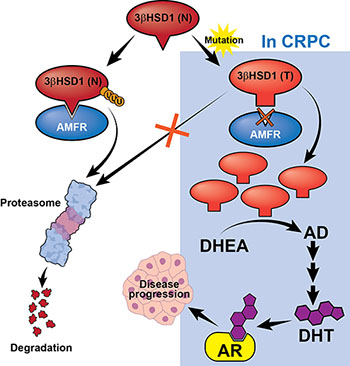


Posted September 2, 2014
Nima Sharifi, MD, Cleveland Clinic Foundation
 The growth of prostate cancer (PC) is fueled by increased androgen synthesis within cells via a mechanism of sustained androgen receptor (AR) signaling. Activated by androgens such as dihydrotestosterone (DHT), the AR signaling pathway has served as a fundamental target of recent FDA approved drugs for PC treatment, like abiraterone. Unfortunately, prolonged therapy with androgen synthesis inhibitors can result in drug resistance and the development of castration-resistant prostate cancer (CRPC). Abiraterone can limit the growth of CRPC, but the presence of residual amounts of a key steroid precursor, dehydroepiandrosterone (DHEA), allows for continued production of the AR activating androgen DHT, promoting abiraterone resistance in CRPC.
The growth of prostate cancer (PC) is fueled by increased androgen synthesis within cells via a mechanism of sustained androgen receptor (AR) signaling. Activated by androgens such as dihydrotestosterone (DHT), the AR signaling pathway has served as a fundamental target of recent FDA approved drugs for PC treatment, like abiraterone. Unfortunately, prolonged therapy with androgen synthesis inhibitors can result in drug resistance and the development of castration-resistant prostate cancer (CRPC). Abiraterone can limit the growth of CRPC, but the presence of residual amounts of a key steroid precursor, dehydroepiandrosterone (DHEA), allows for continued production of the AR activating androgen DHT, promoting abiraterone resistance in CRPC.
The mechanisms that enhance DHT production from DHEA and promote abiraterone resistance in CRPC remain poorly understood. With this in mind and support from FY08 Physician Training Award, Dr. Nima Sharifi and his multidisciplinary team of researchers at the University of Texas Southwestern Medical Center discovered a mutant version of the 3β hydroxysteroid dehydrogenase type 1 enzyme (3βHSD1), that was present in a subset of CRPCs. This mutation, N367T, prevents the enzyme from being ubiquitinated, a key part of the degradation process. By blocking ubiquitination, the 3βHSD1 is not degraded, and remains present in cancer cells much longer than the wild type version.
The sustained presence of the mutant 3βHSD1 enzyme is significant since it in turn activates one of the rate-limiting steps in the androgen synthesis pathway - the conversion of DHEA to androstenedione (AD). By allowing for continued activation of this rate-limiting step, the 367T promotes androgen production and ultimately the growth of CRPC. The discovery of 367T and its role in the androgen synthesis pathway suggests that inhibition of this steroidogenic enzyme may limit prostate cancer. Dr. Sharifi and his team, now located at the Cleveland Clinic Foundation, are working toward the identification of a small molecular inhibitor of this enzyme that may be used for prostate cancer therapy. The added potential for using the N367T mutation as a biomarker for CRPC further emphasizes the significance of this finding and its potential for impact in prostate cancer patients.

The presence of a mutation in the enzyme 3β-hydroxysteroid dehydrogenaseisoenzyme-1 (3βHSD1) in a subset of human CRPC tumors blocks the degradation of 3βHSD1. The result is an increased amount of 3βHSD1 available in the cell, which opens the floodgates to DHT synthesis, permitting tumors to grow in the absence of gonadal testosterone.
Reference:
Links:














